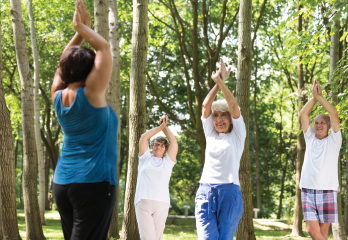
Photographee.eu / shutterstock.com
ACR CONVERGENCE 2020—Research has shown time and again the benefits and low risk of physical activity for people with rheumatic diseases, but only a third or less of patients meet guidelines for this activity, Patricia Katz, PhD, professor of medicine and health policy at the University of California, San Francisco, said in the ARP Distinguished Lecture: How to Promote Physical Activity and Its Benefits for Patients with Rheumatic Diseases. With better counseling by providers, patients would likely boost their activity levels, she said.
“Probably the most important reason people with rheumatic diseases are not exercising is that they’re not getting the message that physical activity is a good thing for them, that it’s beneficial for their disease. And they’re not getting that message from their physician or other healthcare providers—at least not in a meaningful way,” Dr. Katz said.
Moderate to vigorous activity has been associated with a lower risk of disability onset and progression in osteoarthritis, and less sedentary time has been associated with better function.1 In a 10-week program involving 30 minutes of activity three times a week, high-intensity interval walks were linked to a significant decline in disease activity in swollen joints and improvements in physical function.2
Despite anxiety among patients that exercise and physical activity could worsen symptoms or bring on new symptoms, little evidence indicates this is the case, Dr. Katz said.
“Exercise is recognized as safe—it’s been recommended for people with rheumatic muscular and skeletal diseases for quite some time,” she said. The ACR’s guidelines for managing osteoarthritis include physical activity and exercise.
Studies Find Exercise Reduces Pain

Dr. Katz
Studies of exercise interventions have generally shown that they produce reductions in pain. A study of the Arthritis Foundation’s Walk with Ease, a six-week, community-based program, for example, found that both a self-directed program and a group format produced an 8-point drop on the 100-point Visual Analog Scale to measure pain.3
“There’s actually reason to think that physical activity might change central pain processing, which might explain why we see these reductions,” Dr. Katz said.
Still, only 20–30% of those with rheumatic diseases meet physical activity guidelines—and that’s by self-report, so the actual numbers are probably even lower, she said.4
Physical Activity Can Reduce Fatigue
Research has also shown that physical activity can help with fatigue, a common problem for people with rheumatic diseases.
In 2016, Dr. Katz led a study that included home visits with 158 patients with rheumatoid arthritis (RA) and conducted comprehensive assessments to look for factors associated with RA, as well as factors not associated with RA, that may contribute to fatigue. They found that depression, poor sleep and obesity were independently associated with fatigue, with physical activity also playing a role but mediated by the other three factors.5
A study Dr. Katz had published in 2018, called PARAFit, for Physical Activity to Improve RA Fatigue, set out to test a physical activity intervention that was less costly and complex than previous such efforts, and therefore more accessible and practical, to try to improve fatigue. Researchers enrolled 96 participants with moderate levels of fatigue and who weren’t currently exercising.6
‘Exercise is recognized as safe—it’s been recommended for people with rheumatic muscular & skeletal diseases for quite some time.’ —Patricia Katz, PhD
Patients had a baseline visit and wore an activity monitor for a week to establish a baseline activity level. The monitor had no readout on steps for the patients to see, so that their behavior would be less likely to change. They came back for another visit, then were randomized to a group that received educational materials, a pedometer and a step diary; or one that received the educational materials, pedometer and a step diary, and were given step goals; or a control group that received only educational materials.
The goals were based on the baseline monitoring and were designed to increase steps by about 10% every two weeks, an amount considered manageable. Patients had a median of about 4,200 steps a day at baseline, which is well below the threshold for a sedentary lifestyle. They also had moderate disease activity and moderate levels of disability.
Researchers found that the rate of sedentary behavior significantly declined in the two intervention groups compared to the control group, in which the rate of sedentary behavior increased (P=0.04). The two intervention groups also showed significant declines in fatigue levels (P=0.02 for the pedometer-only group and P=0.0002 for the pedometer and goals group).
Those with higher levels of baseline fatigue, those with a shorter disease duration and those with higher levels of depressive symptoms were more likely to have a meaningful decrease in fatigue, Dr. Katz said.
Beyond fatigue, exercise has also been shown to be a potent treatment for depression, Dr. Katz noted, with studies suggesting that it is equivalent to psychological therapy and pharmacological therapy.7
Cognitive impairment, shown to be common in some rheumatic conditions, has also been linked with physical inactivity. A study by Dr. Katz et al. in 2012, based on self-reported activity by women with lupus, found that inactivity was associated with an elevated risk of impairment in memory and executive function.8
Perceived barriers to physical activity abound for people with rheumatic diseases, including disease activity, fatigue, concerns about harming joints and a general lack of motivation, along with such structural barriers as having a safe place to exercise, financial barriers and not having exercise programs tailored to rheumatic conditions, Dr. Katz said.
Medical Recommendation Important
But recommendations for exercise from healthcare providers have been shown to be closely associated with levels of physical activity. These recommendations might not always be made, she suggested, because some physicians might feel they’re not qualified to make such recommendations and feel pressed for time in the clinic.
“There are a lot of things to cover in that very short period and having counseling on physical activity may just be a bridge too far in that setting,” Dr. Katz said.
Little Steps Can Help
But the recommendations can be simple, she said. Exercise sessions can be any length, although new forms of exercise should be undertaken incrementally. Simple steps, such as taking the stairs instead of the elevator or parking a bit farther away from a store entrance, are helpful.
“Even small increases are important,” Dr. Katz said. “Any activity is better than no activity.”
Thomas Collins is a freelance medical writer based in Florida.
References
- Dunlop DD, Song J, Semanik PA, et al. Relation of physical activity time to incident disability in community dwelling adults with or at risk of knee arthritis: Prospective cohort study. BMJ. 2014 Apr 29;348:g2472.
- Bartlett DB, Willis LH, Slentz CA, et al. Ten weeks of high-intensity interval walk training is associated with reduced disease activity and improved innate immune function in older adults with rheumatoid arthritis: A pilot study. Arthritis Res Ther. 2018 Jun 14;20(1):127.
- Callahan LF, Shreffler JH, Altpeter M, et al. Evaluation of group and self-directed formats of the Arthritis Foundation’s Walk With Ease Program. Arthritis Care Res (Hoboken). 2011 Aug;63(8):1098–1107.
- Iversen MD, Frits M, von Heideken J, et al. Physical activity and correlates of physical activity participation over three years in adults with rheumatoid arthritis. Arthritis Care Res (Hoboken). 2017 Oct;69(10):1535–1545.
- Katz P, Margaretten M, Trupin L, et al. Role of sleep disturbance, depression, obesity, and physical inactivity in fatigue in rheumatoid arthritis. Arthritis Care Res (Hoboken). 2016 Jan;68(1):81–90.
- Katz P, Margaretten M, Gregorich S, et al. Physical activity to reduce fatigue in rheumatoid arthritis: A randomized controlled trial. Arthritis Care Res (Hoboken). 2018 Jan;70(1):1–10.
- Cooney GM, Dwan K, Greig CA, et al. Exercise for depression. Cochrane Database Syst Rev. 2013 Sep 12;(9):CD004366.
- Katz P, Julian L, Tonner MC, et al. Physical activity, obesity, and cognitive impairment among women with systemic lupus erythematosus. Arthritis Care Res (Hoboken). 2012 Apr;64(4):502–510.


